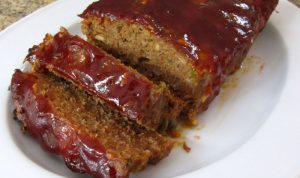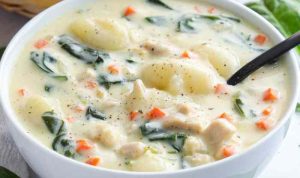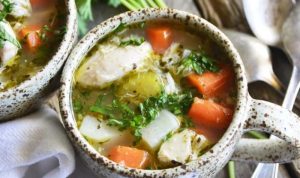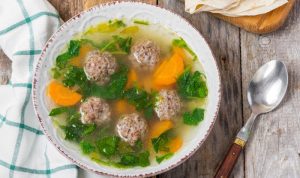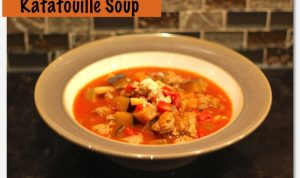A Deep Dive into Beef Soup Recipes
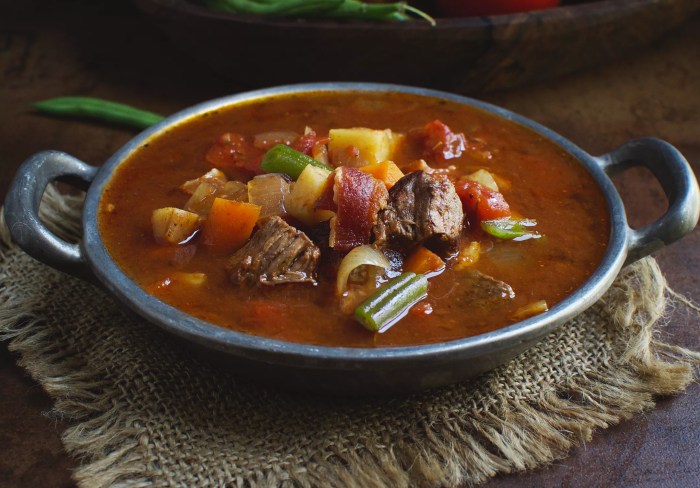
Source: simplysohealthy.com
Beef soups recipe – Beef soup, a culinary staple across the globe, boasts a rich history and diverse variations. From hearty stews to delicate broths, its versatility reflects the cultural tapestry of countless societies. This exploration delves into the art of crafting delectable beef soups, covering essential ingredients, preparation methods, flavorful variations, and serving suggestions.
Beef soups offer a hearty and comforting meal, with countless variations depending on your preferences. A particularly convenient option is the slow-cooked variety, and for those seeking a healthier twist, you might consider a vegetable-rich version. A fantastic resource for this is a great vegetable beef soup recipe for crock pot , perfect for busy weeknights. Ultimately, the best beef soup recipe is the one that best suits your taste and lifestyle.
A Culinary History and Global Variations of Beef Soup

Source: tasteofhome.com
Beef soup’s origins are as diverse as its modern forms. Ancient civilizations likely utilized readily available beef and broth for sustenance, leading to early forms of the dish. Over time, regional variations emerged, reflecting unique ingredients and culinary traditions. The following table showcases some popular examples.
| Name | Origin | Key Ingredients | Notable Characteristics |
|---|---|---|---|
| Beef Stew | United Kingdom | Beef, potatoes, carrots, onions, barley | Hearty, thick consistency, often served with dumplings. |
| Pho | Vietnam | Beef broth, rice noodles, herbs (basil, cilantro), lime | Light yet flavorful broth, served with various beef cuts. |
| Consommé | France | Clarified beef broth, vegetables, herbs | Crystal-clear broth, elegant and refined. |
| Beef Barley Soup | Germany | Beef broth, barley, carrots, celery, potatoes | Hearty and filling, often served with a side of crusty bread. |
Nutritionally, beef soup offers a wealth of benefits. It’s a good source of protein from the beef, essential vitamins and minerals from vegetables, and provides hydration through the broth. The specific nutritional content varies depending on the recipe and ingredients used.
Essential Ingredients and Their Roles in Beef Soup, Beef soups recipe
The foundation of any great beef soup lies in the quality of its ingredients. Careful selection ensures a flavorful and nutritious final product.
- Beef Broth: Forms the base, providing flavor and richness. Homemade broth is preferred for superior taste.
- Beef: The star ingredient, contributing protein and umami flavor. Choosing high-quality cuts is crucial.
- Vegetables: Add nutrients, texture, and visual appeal. Common choices include carrots, celery, onions, potatoes.
- Herbs and Spices: Enhance the flavor profile. Bay leaves, thyme, parsley, black pepper are frequently used.
Alternative ingredients can be substituted based on availability and preference.
- Chicken broth can replace beef broth for a lighter flavor.
- Different vegetables like turnips, parsnips, or mushrooms can be added for variety.
- Other herbs like rosemary or oregano can be used to alter the flavor profile.
Selecting high-quality beef is paramount. Look for cuts with good marbling for richer flavor and tenderness. Grass-fed beef is often favored for its healthier fat profile.
Mastering Beef Soup Preparation Methods
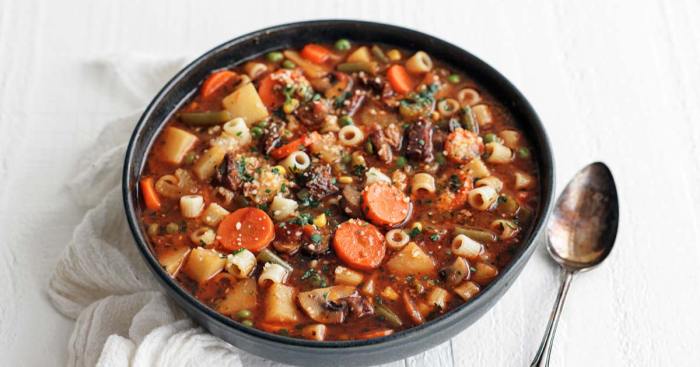
Source: billyparisi.com
Several methods can be employed to prepare beef soup, each yielding slightly different results.
- Preparation: Brown the beef cubes in a large pot or Dutch oven over medium-high heat until browned on all sides. This step develops rich flavor and color.
- Sautéing Aromatics: Add chopped onions, carrots, and celery to the pot and sauté until softened.
- Simmering: Pour in the beef broth, add herbs and spices, bring to a boil, then reduce heat and simmer for at least 2 hours, or until the beef is tender. Skimming off any foam that rises to the surface will result in a clearer broth.
- Finishing Touches: Season with salt and pepper to taste. Add any other desired vegetables (potatoes, etc.) during the last 30 minutes of cooking.
Stovetop cooking offers precise temperature control, while slow cookers provide a hands-off approach resulting in exceptionally tender beef. Pressure cookers significantly reduce cooking time, achieving tenderness in a fraction of the time.
Proper browning of the beef is essential for developing a deep, rich flavor. Sear the beef cubes in batches to ensure even browning and avoid overcrowding the pot, which can lead to steaming instead of browning.
Exploring Diverse Beef Soup Variations
The world of beef soup encompasses countless variations, each with its unique characteristics.
| Recipe Name | Region of Origin | Unique Ingredients | Cooking Techniques |
|---|---|---|---|
| French Onion Soup | France | Caramelized onions, croutons, Gruyère cheese | Slow simmering of onions, broiling for cheese |
| Pho | Vietnam | Star anise, cinnamon, cloves, fish sauce | Slow simmering of broth, served with fresh herbs |
| Beef Stroganoff Soup | Russia | Mushrooms, sour cream, paprika | Sautéing mushrooms, simmering in a creamy sauce |
A detailed recipe for Beef Stroganoff Soup follows:
- Brown beef cubes and sauté onions and mushrooms.
- Add beef broth, paprika, and simmer until beef is tender.
- Stir in sour cream and season with salt and pepper.
- Serve hot, optionally garnished with fresh parsley.
Serving and Enhancing Beef Soup: Tips and Suggestions
Elevating your beef soup to perfection involves thoughtful presentation and flavorful enhancements.
Garnishes such as fresh herbs (parsley, cilantro), a squeeze of lemon juice, or a dollop of sour cream can significantly enhance the flavor and visual appeal. Different types of noodles, such as egg noodles or even rice noodles, can be added for extra texture and substance. Storing leftover soup properly is crucial to maintain its quality. Allow the soup to cool completely before storing it in airtight containers in the refrigerator for up to 3-4 days.
Reheat gently on the stovetop or in the microwave.
Side dishes that complement beef soup include crusty bread for dipping, a simple green salad, or even a side of mashed potatoes.
Visual Appeal of a Perfect Beef Soup
A well-made beef soup should be visually appealing, reflecting the care and attention given to its preparation. The ideal texture is a balance of tender beef and well-cooked vegetables, with a clear or slightly cloudy broth. The color should be rich and inviting, ranging from deep brown to amber, depending on the ingredients and cooking method.
Different variations will have distinct visual characteristics. French onion soup will showcase the deep brown color of caramelized onions and the golden-brown melted cheese on top. Pho’s broth will be a lighter, clearer amber, with visible herbs and noodles. Beef Stroganoff soup will have a creamy, slightly thicker consistency and a rich brown color from the beef and paprika.
Images accompanying the recipe could depict the stages of browning the beef, the simmering process, the addition of vegetables, and finally, the finished product in a warm, inviting bowl, possibly garnished with fresh herbs.
Question & Answer Hub: Beef Soups Recipe
Can I use frozen beef for beef soup?
Yes, but ensure it’s completely thawed before browning to prevent uneven cooking. Pat it dry to help achieve a good sear.
How long can I store leftover beef soup?
Leftover beef soup can be stored in an airtight container in the refrigerator for up to 3-4 days.
What are some good side dishes to serve with beef soup?
Consider crusty bread, a simple green salad, or grilled cheese sandwiches to complement the flavors of your beef soup.
Can I make beef soup in a slow cooker?
Absolutely! Slow cookers are ideal for beef soup, allowing the flavors to meld beautifully over several hours. Adjust cooking times accordingly.

